Far From Boring:
Meet the Most Interesting Tunnel Boring Machines
January 25th, 2018 by ant6n
Right now in Los Angeles, Elon Musk is playing in the dirt with his shiny new toy, a second-hand tunnel-boring machine (“TBMâ€) named “Godotâ€. He hopes to revolutionize car travel by building highways underground, in “going 3dâ€.
Musk’s antics have already drawn criticism from transit-planning experts. Jarrett Walker points out that Musk’s ideas are inherently anti-urban and anti-transit. Alon Levy shows that the technological claims Musk makes about tunnel technology are bogus: Musk seems to believe that there are a lot of low-hanging fruits to improve tunneling technology, whereas in reality, the technology is already very advanced.
People tend to think it’s the tunnels that are the most expensive part of underground systems like metros, but thanks to the already existing TBM technology, they often represent only a small portion of the overall cost. Sometimes as little as 10%.
The most expensive parts of subways are the stations. In my view, modern boring technology becomes interesting when we can use it not just for the tunnels in-between the stations, but to build the complete system, including the stations, cheaper.
Many tunnel building innovations have been developed by various companies to deal with real-world constraints. They give us TBMs like these:
The Giant TBM
Musk says he can build tunnels cheaper if he just makes them smaller. But in reality, it’s not small TBMs that are the future, but big ones. The cost of a TBM doesn’t get much higher as you increase its diameter. Tt is therefore cheaper to build one very large tunnel, rather than two smaller ones. So giant, linear tunnel building factories have been constructed, with some reaching up to 17.6m in diameter.

The two phases of tunneling: pushing forward & installing the tunnel lining (check out the full video here)
A large diameter tunnel becomes really interesting for the construction of a metro, if it is large enough to fit not only the tracks, but the station platforms inside it. This saves costs because it’s unnecessary to excavate large caverns, possibly dug from above requiring the purchase of a large amount of land.
A large diameter tunnel was used for Barcelona’s line 9/10 project, where the tunnel is so big that two tracks and two platforms can be stacked above each-other, inside a single tunnel.
These arge tunnel can also house other necessary infrastructure: siding tracks to park trains at night, ramps so trains can cross over from one level to the other, evacuation paths, power substations — all items requiring space and cost.
Other projects used very large TBMs to build tunnels hosting six lanes of highways on two levels, plus emergency evacuation and ventilation, all inside a single tube (Madrid, Seattle). There are also water or sewer tunnels.
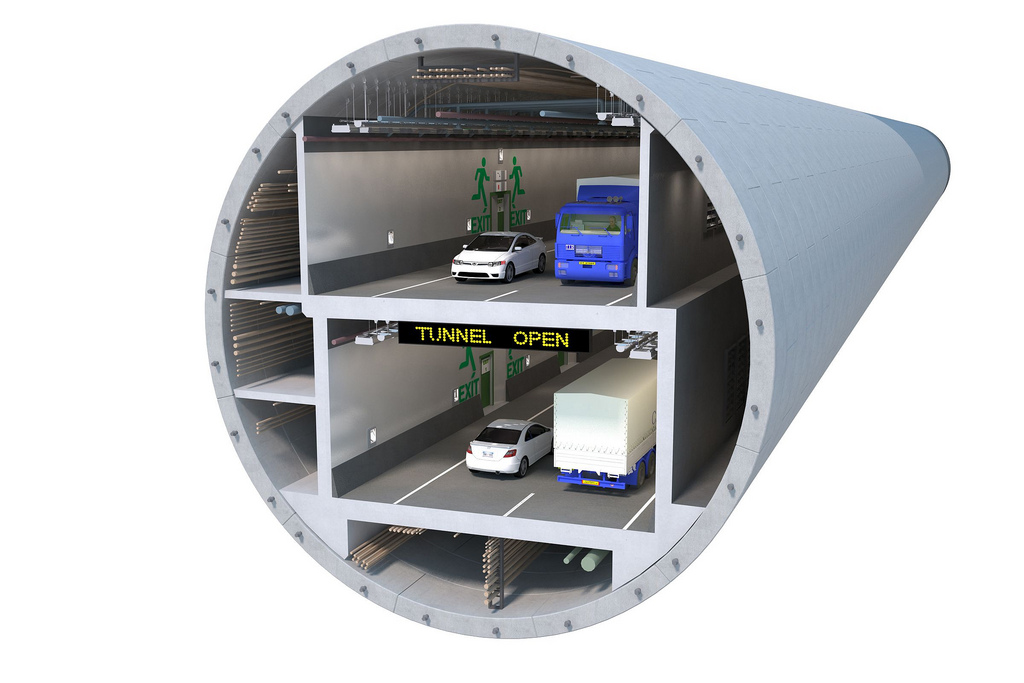
State Route 99 tunnel (source)
One interesting project in Kuala Lumpur, called “SMART Tunnelâ€, combines a four lane highway tunnel with a storm drain. During major storms, the road is closed and the whole tunnel is used to carry stormwater.
Other projects combine rail and road in one tunnel. In Wuhan, China, a twin-tube tunnel under the Yangze River, currently under construction, combines a highway on the upper deck with a metro line on the lower one.
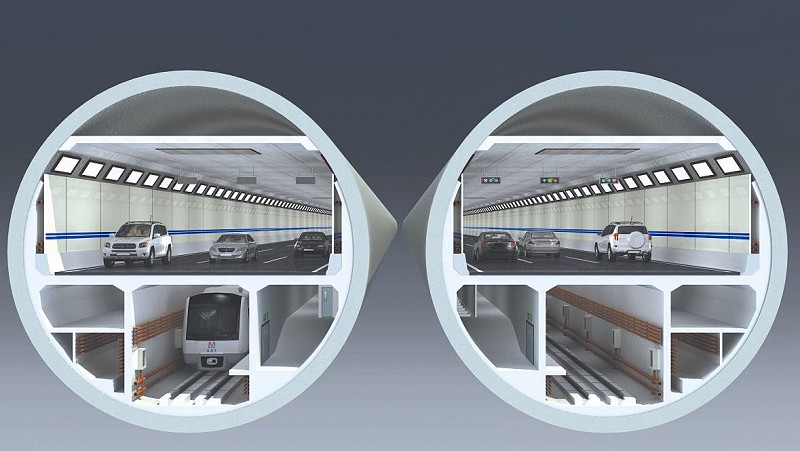
Wuhan Metro line 7 tunnel (source)
The Vertical TBM
Let’s say you’ve built your metro line using a giant TBM, and installed platforms inside the tunnels — you’ll still need to access those stations from the surface. Traditionally, you would dig some access shafts. This may be slow, labor-intensive, and complicated if there’s ground-water. But in the interesting new world of tunnel technology, there’s a TBM for that: the “vertical shaft sinking machineâ€.
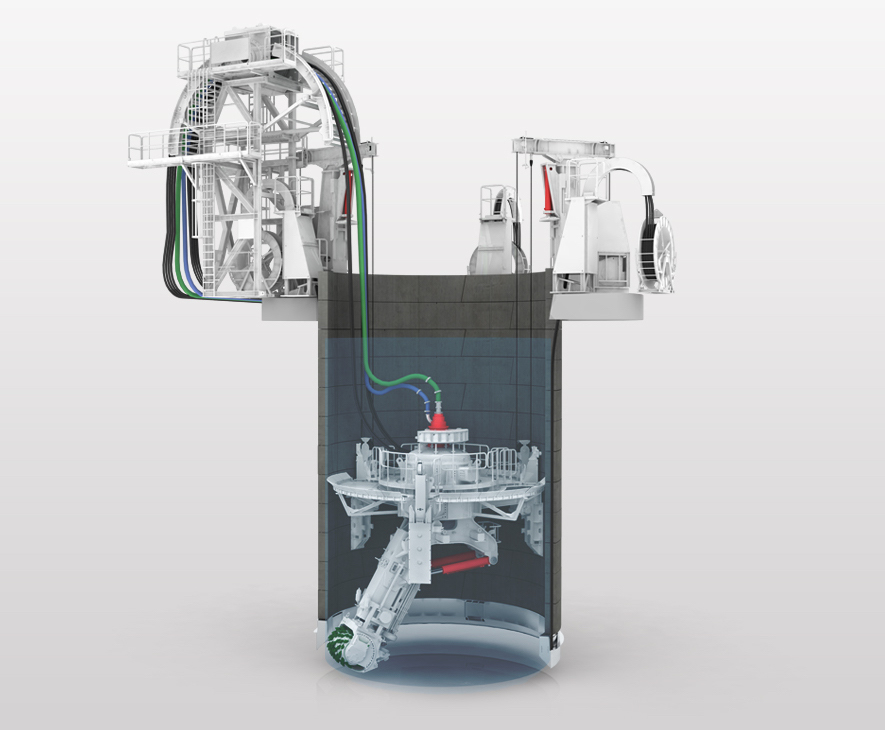
Vertical Shaft Sinking Machine (source)
It’s a machine that consists of an excavator at the bottom of the tunnel that removes the earth, and machines at the top that build the tunnel lining rings that are being pushed down from above.
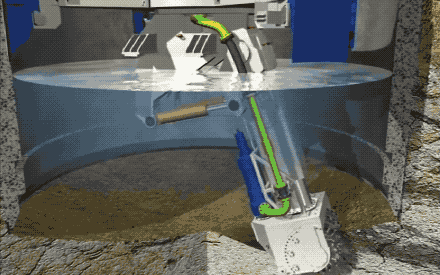
digging and adding rings (source)
The trick here is that rings are installed at the top of the shaft and then the whole shaft is pushed down. It leaves a lot of the complex technology at the surface. It also means you don’t end up with a big machine at the bottom, without an escape: most TBMs can’t go backwards because they’re bigger than the tunnel they’re building, so they need an opening on the other end to escape the underground (or be taken apart at the end).
At the bottom, the excavator can work under water, so the shaft can have the same ground-water level as the surrounding environment, until the desired depth is reached and the a concrete seal is poured at the bottom.
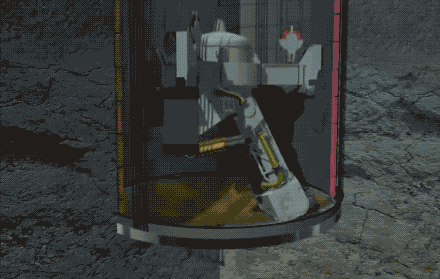
pouring the bottom seal (source)
With this machine it would be relatively simple to build access shafts for elevators, to access our hypothetical metro line.
The Diagonal TBM
We could now build our subway line deep underground inside giant tunnels, and vertical shafts down to provide elevator accesses. The thing is, if you want a lot of people to access your station, you need escalators, which move many more people per hour. This means we want tunnels to be neither vertical or horizontal, but built at the 30 degree angle of escalators.
In 1997, Saint-Petersburg opened an extension of its line 5, very deep underground. But one 102m deep station, Admiralteyskaya, wasn’t opened until more than a decade later, because they couldn’t figure out how to build a connection to the surface. For all this time, trains just ran through this ghost station but didn’t stop there, since there was no connection to the surface.
The problem was that there are a lot of museums and heritage buildings nearby and the ground is composed of a soft soil. The usual solution to freeze the ground and treat it like rock was deemed too risky, as the ground expansion from the freezing could damage the buildings (oh also, they ran out of money, and they had trouble finding a plot of land to use for the station).
In the end, they came up with a tunnel boring machine that digs at an angle. The machine takes away soil and immediately replaces it with a tunnel, minimizing movement of the ground. This allows digging without affecting the environment.
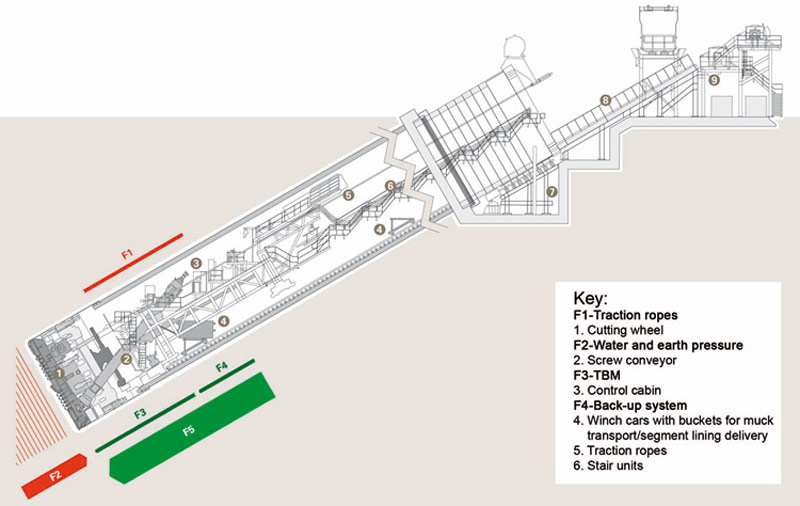
Side view of the TBM (source)
In a way, building tunnels barely more than 100m with a TBM seems crazy. Setting up a tunnel “factory†only makes sense when you have a lot of tunnel to build. To make this economical, the TBM was made as re-usable as possible. Once the TBM reaches the bottom, most of it is disassembled and moved to the next site. The only thing that stays underground is the tunnel shield, the big protective metal sheath at the front of the TBM under which the tunnel lining is assembled – because it’s wider than the tunnel.
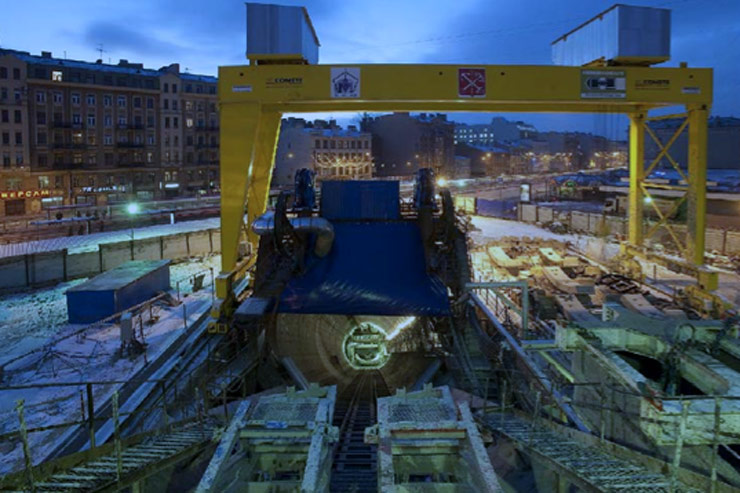
View down the angled shaft (source)
In the end, three angled tunnels were built, at lengths between 105m and 160m allowing three new stations to open. The Admiralteyskaya station opened in 2011, about 14 years after the line itself.
The Rectangular TBM
One issue with traditional TBMs is that they build tunnels with a circular cross section. But the internal cross-section of tunnels usually needs to be rectangular; generally we want a flat bottom, walls going straight up, with some relatively constant ceiling height.
If we use a circular TBM to build a tunnel, we have a bunch of wasted space on the sides. This can be especially an issue when space is at a premium, or if we want to build tunnels as close as possible to the surface.
This is especially true for underpasses, which have to be as close to the surface as possible and which also have a relatively small height (as little as 2.2m) but require a good amount of width (4m and more). Traditionally, these would be constructed using cut-and-cover: the road would be dug up, the tunnel placed in, and the road rebuilt on top. This can be a major disruption to the surface roads above.
To deal with all of these issues, some tunnelling technology companies have started to offer a new kind of tunnel boring machine: the rectangular TBM.
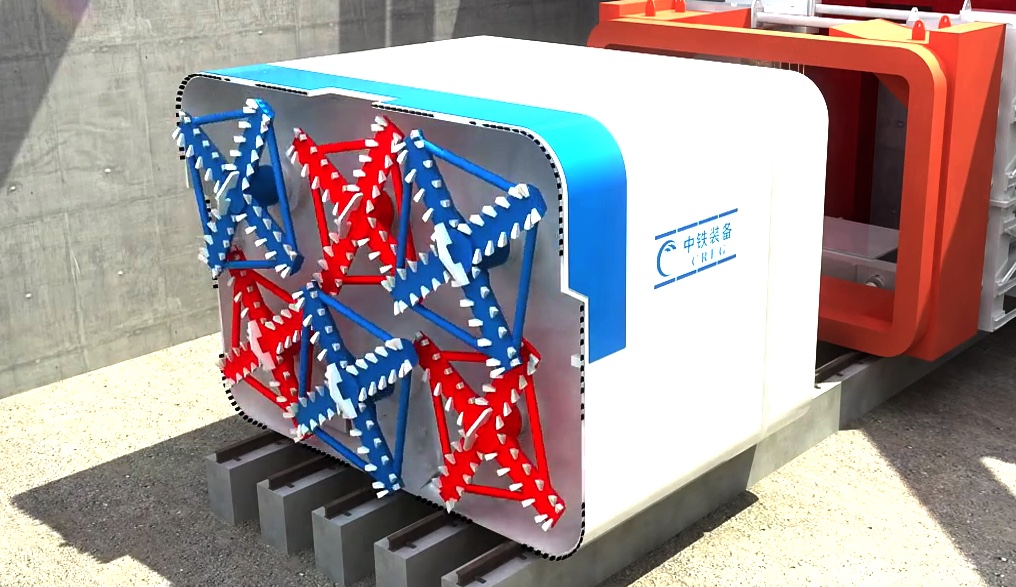
the rectangular TBM (source)
The idea, proposed by a German company but already built and used by a Chinese one, is to have a small rectangular digger. They can be used to build short, low-depth tunnels, in space-constrained environments, while minimizing surface impacts (which may also reduce costs).
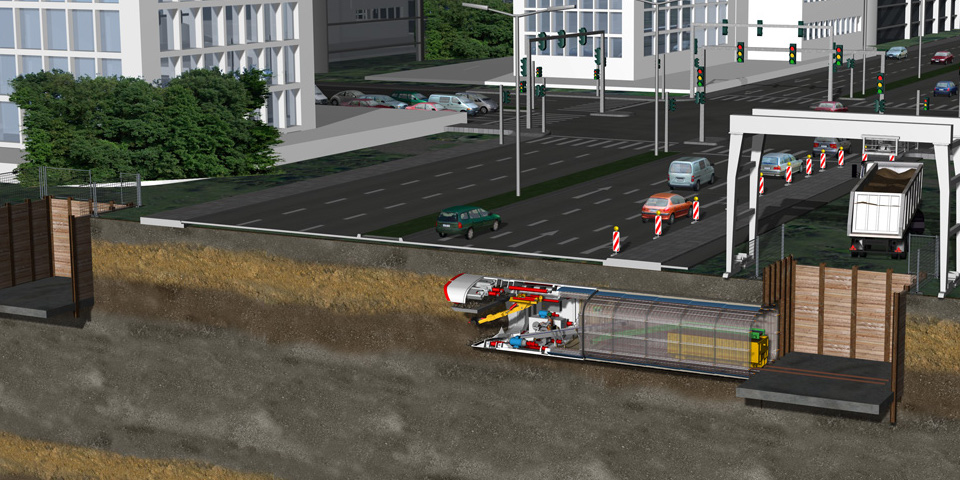
A rectangular TBM digging an underpass (source)
Rather than including a facility for assembling the tunnel lining (out of multiple segments) inside the TBM, complete rings are inserted at the insertion shaft, and the whole tunnel is jacked forward one segment at a time.
This technology was used to build a metro access at the Havelock Metro Station in Singapore. The company hopes that this technology could be used one day to build whole stations.
A station built using this rectangular TBM concept could be very interesting: unlike the ‘giant’ TBMs mentioned before, this technology could allow building stations close to the surface, in much more spatially constrained environments, and allowing a passenger platforms to be side-by-side rather than stacked.
Conclusion
When building transportation systems, constraints are usually about physics, geometry and cost, not the technology (see my criticism of the “Gadgetbahnâ€).
I think that we have to be careful of primarily technology-based “solutions†to transportation problems. Musk is trying to sell a quick-fix technology that in real life won’t be able to escape geometry and physics. His approach makes little sense, his understanding of cities is poor … but also, his technology is boring.
On the other hand, technology can provide interesting tools to advance projects anchored in the real world, and push geometric, physical, time and cost constraints to its limits.
For more reading on tunnel technology, I recommend the website TunnelTalk, and the Tunneling Products Page of Herrenknecht, which I’ve both heavily linked in this article.
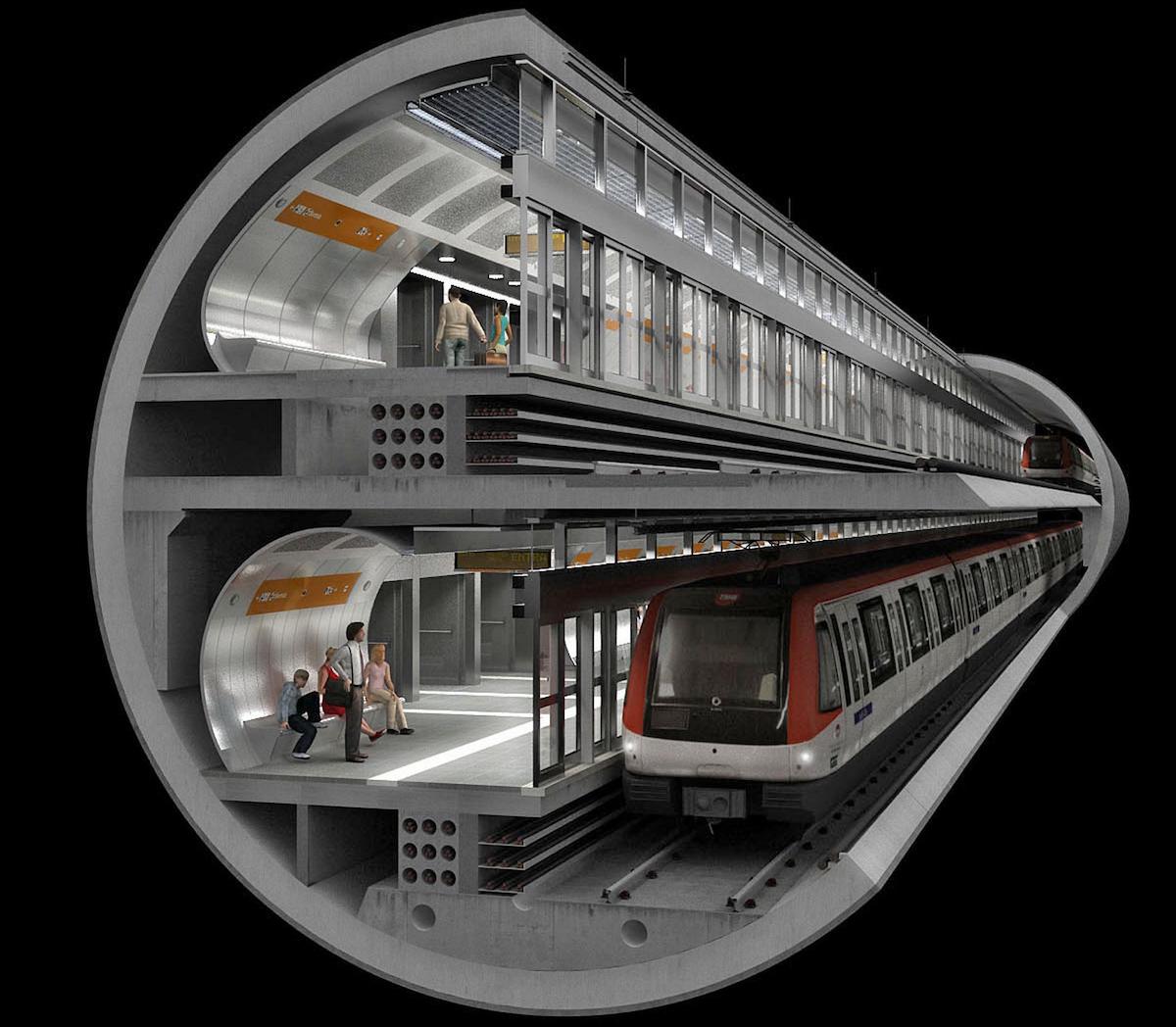
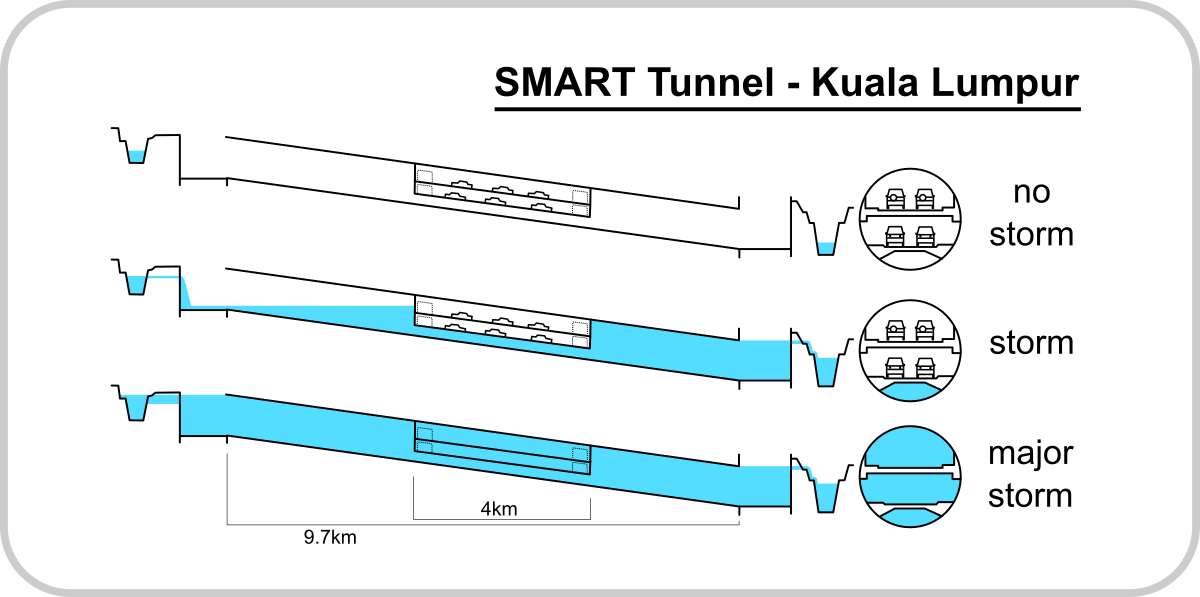
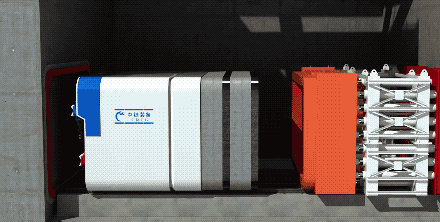
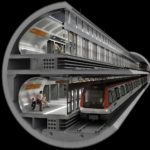


January 25th, 2018 at 11:16
Quick Note: There is a typo in the link to Tunnel Talk: “https”, not “htpps”.
Otherwise, at least in Vancouver (where we have a vertically-stacked tunnel downtown on the original Expo line), that mode makes it difficult to build switches between directions that would help when a train was stuck on track. The Expo line in particular is notorious for shutting down completely when a train is broken down somewhere. There are good reasons to have a third track as much as possible, or to go ‘side by each’ to get around these snags.
The rectangular cut just below the surface wouldn’t have worked on the Canada line to the airport either, primarily because it ran just below a long-established road (Cambie street) that is on top of all sorts of miscellaneous power, telecommunications and other wiring, and a myriad of pipes. They had to build supports and u-channel bridges to support all the existing stuff as they carefully went slightly deeper. Deep gets away from all that crap. It also means that you don’t have to slavishly follow road alignments, as did the Canada line during construction.
January 25th, 2018 at 14:45
@Ace
That’s a good point about the issues with stacked tracks. But note that the Barcelona line has ramps between the tracks (see photos of that my article).
February 22nd, 2018 at 12:53
@ant6n With the cost of boring becoming more affordable, why nobody is considering a second tunnel under the Mont-Royal? Why not connect Parc Station to Gare Centrale and use it to have the future Via’s TGF, RTM’s Mascouche and Saint-Jerome lines use it? No new station would need to be built in between…
February 24th, 2018 at 20:46
@Sam
Building a second Mount-Royal tunnel would still be quite expensive. It’s not just the tunnelling of several km, but also the very complicated insertion into Gare Centrale. The cost would probably be 1-2billion, which probably doesn’t have a great cost-benefit right now (given that the St-Jerome and Mascouche line are on freight lines and limited by frequency). For now, I’d say it would be much cheaper to share the existing Mount-Royal tunnel, although it would be great if a second tunnel connection had been considered for the future…
March 3rd, 2018 at 12:24
Affordable is a relative term. Yes, there are things you can do to make tunneling cheaper but at the core of it, tunneling anything is just really, really expensive. Especially, when you have to make the argument to politicians who only see all the other things that this tunneling money could be doing. It’s often a really hard sell to have to make.
March 6th, 2018 at 21:03
Why would you build another tunnel under Mount Royal (ignoring the REM boondoggle) for trains carrying 10s of thousands (maybe) when there are dusty plans for extending Line 5 in multiple directions that would likely carry 100s of thousands of people?
Look at all the bus routes in the “quadrant” between Line 1 and Line 2 (east of Line 2, north of Berri and north of Line 1 east of Berri) that carry 30,000 passengers a day. The Mascouche RTM line is what? A quarter of that?
I’m not a fan of Mme Plante’s Pink line but the area to be served by it is underserved now. Dust off those Blue Line plans … any of them! … and build one of them!
Aside: Looking at STM ridership numbers is fun. They change how the report them every few years, or seem to, and that’s only for the routes you can find numbers for. I also note that they seem to add new routes where there is heavy ridership and that tends to hide the cumulative demand in a corridor – where did those 40k+/day riders on the 67-St Michel go? No idea – not reported after 2008! Where is the “MBTA Blue Book” for the STM?!?!?
March 6th, 2018 at 21:05
Oh! And thanks for the update on tunnel boring, @ant6n! I’m #notamuskfluffer either but hadn’t paid much attention to his tunneling thing (other than to dismiss it) but am glad to see my gut feeling was probably justified.
March 13th, 2018 at 13:03
A lot of people are upset with CDPQ “stealing” the tunnel… And I do understand all the issues and challenges that this will bring mostly on the RTM train service and the potential TGF service that could have used it… Yes “could” because nothing concrete has been budgeted yet for it except new studies (really!?). The truth is that this is an old tunnel that no longer is safe according to current standards. So the hope is that with the REM at least the needed upgrades will be done… Yes building another tunnel would cost a lot but I don’t see how this would be a bad debt. It’s a little upsetting that people in charge seem unable to see the bigger picture when it come to invest in bigger infrastructure. I don’t buy the “it’s too expensive” or “the population is not big enough”…
March 10th, 2019 at 23:09
You say “The cost of a TBM doesn’t get much higher as you increase its diameter. Tt is therefore cheaper to build one very large tunnel, rather than two smaller ones” but that doesn’t logically follow, for two reasons:
Firstly, it assumes that two smaller tunnels would be constructed in parallel. Were they instead constructed in series, one TBM would be sufficient.
Secondly, AIUI the cost of the TBM is only a small proportion of the total cost. Other obvious costs include the cost of the crew, the cost of the tunnel linings and the cost of removing the spoil. How do these compare on different sized tunnels?
November 24th, 2019 at 16:19
Never knew I wanted to be caught up on Tunnel boring devices, but found this fascinating stuff. Well done.
December 17th, 2020 at 10:07
With the recent REM de l’Est announcement, now is a good time for you to revive this blog!